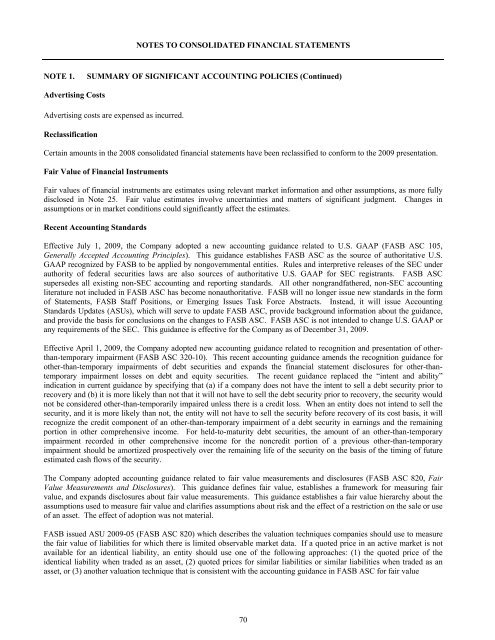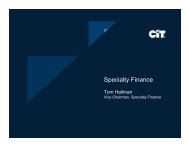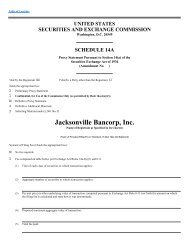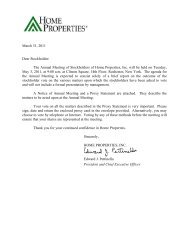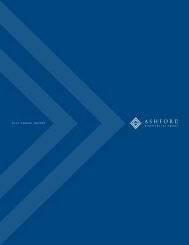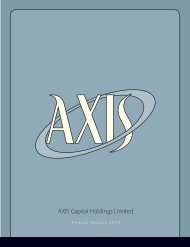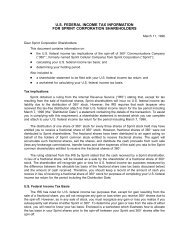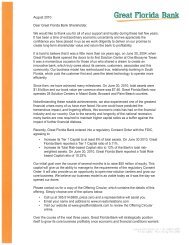pab bankshares, inc. - SNL Financial
pab bankshares, inc. - SNL Financial
pab bankshares, inc. - SNL Financial
You also want an ePaper? Increase the reach of your titles
YUMPU automatically turns print PDFs into web optimized ePapers that Google loves.
NOTES TO CONSOLIDATED FINANCIAL STATEMENTS<br />
NOTE 1.<br />
SUMMARY OF SIGNIFICANT ACCOUNTING POLICIES (Continued)<br />
Advertising Costs<br />
Advertising costs are expensed as <strong>inc</strong>urred.<br />
Reclassification<br />
Certain amounts in the 2008 consolidated financial statements have been reclassified to conform to the 2009 presentation.<br />
Fair Value of <strong>Financial</strong> Instruments<br />
Fair values of financial instruments are estimates using relevant market information and other assumptions, as more fully<br />
disclosed in Note 25. Fair value estimates involve uncertainties and matters of significant judgment. Changes in<br />
assumptions or in market conditions could significantly affect the estimates.<br />
Recent Accounting Standards<br />
Effective July 1, 2009, the Company adopted a new accounting guidance related to U.S. GAAP (FASB ASC 105,<br />
Generally Accepted Accounting Pr<strong>inc</strong>iples). This guidance establishes FASB ASC as the source of authoritative U.S.<br />
GAAP recognized by FASB to be applied by nongovernmental entities. Rules and interpretive releases of the SEC under<br />
authority of federal securities laws are also sources of authoritative U.S. GAAP for SEC registrants. FASB ASC<br />
supersedes all existing non-SEC accounting and reporting standards. All other nongrandfathered, non-SEC accounting<br />
literature not <strong>inc</strong>luded in FASB ASC has become nonauthoritative. FASB will no longer issue new standards in the form<br />
of Statements, FASB Staff Positions, or Emerging Issues Task Force Abstracts. Instead, it will issue Accounting<br />
Standards Updates (ASUs), which will serve to update FASB ASC, provide background information about the guidance,<br />
and provide the basis for conclusions on the changes to FASB ASC. FASB ASC is not intended to change U.S. GAAP or<br />
any requirements of the SEC. This guidance is effective for the Company as of December 31, 2009.<br />
Effective April 1, 2009, the Company adopted new accounting guidance related to recognition and presentation of otherthan-temporary<br />
impairment (FASB ASC 320-10). This recent accounting guidance amends the recognition guidance for<br />
other-than-temporary impairments of debt securities and expands the financial statement disclosures for other-thantemporary<br />
impairment losses on debt and equity securities. The recent guidance replaced the “intent and ability”<br />
indication in current guidance by specifying that (a) if a company does not have the intent to sell a debt security prior to<br />
recovery and (b) it is more likely than not that it will not have to sell the debt security prior to recovery, the security would<br />
not be considered other-than-temporarily impaired unless there is a credit loss. When an entity does not intend to sell the<br />
security, and it is more likely than not, the entity will not have to sell the security before recovery of its cost basis, it will<br />
recognize the credit component of an other-than-temporary impairment of a debt security in earnings and the remaining<br />
portion in other comprehensive <strong>inc</strong>ome. For held-to-maturity debt securities, the amount of an other-than-temporary<br />
impairment recorded in other comprehensive <strong>inc</strong>ome for the noncredit portion of a previous other-than-temporary<br />
impairment should be amortized prospectively over the remaining life of the security on the basis of the timing of future<br />
estimated cash flows of the security.<br />
The Company adopted accounting guidance related to fair value measurements and disclosures (FASB ASC 820, Fair<br />
Value Measurements and Disclosures). This guidance defines fair value, establishes a framework for measuring fair<br />
value, and expands disclosures about fair value measurements. This guidance establishes a fair value hierarchy about the<br />
assumptions used to measure fair value and clarifies assumptions about risk and the effect of a restriction on the sale or use<br />
of an asset. The effect of adoption was not material.<br />
FASB issued ASU 2009-05 (FASB ASC 820) which describes the valuation techniques companies should use to measure<br />
the fair value of liabilities for which there is limited observable market data. If a quoted price in an active market is not<br />
available for an identical liability, an entity should use one of the following approaches: (1) the quoted price of the<br />
identical liability when traded as an asset, (2) quoted prices for similar liabilities or similar liabilities when traded as an<br />
asset, or (3) another valuation technique that is consistent with the accounting guidance in FASB ASC for fair value<br />
70


